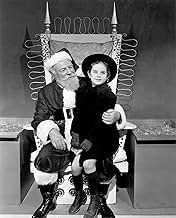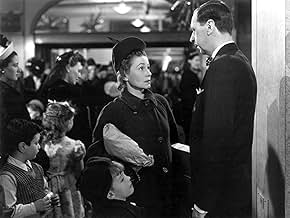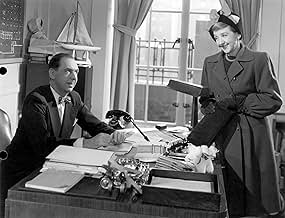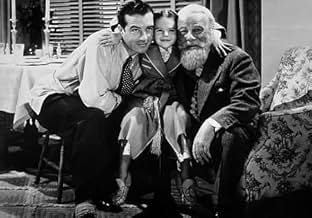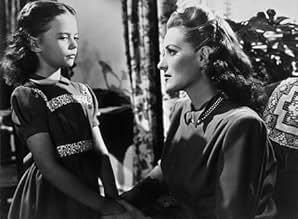AVALIAÇÃO DA IMDb
7,9/10
58 mil
SUA AVALIAÇÃO
Quando um velho simpático que diz ser Papai Noel é tomado por louco, um jovem advogado decide defendê-lo, argumentando em tribunal que ele é o real.Quando um velho simpático que diz ser Papai Noel é tomado por louco, um jovem advogado decide defendê-lo, argumentando em tribunal que ele é o real.Quando um velho simpático que diz ser Papai Noel é tomado por louco, um jovem advogado decide defendê-lo, argumentando em tribunal que ele é o real.
- Direção
- Roteiristas
- Artistas
- Ganhou 3 Oscars
- 10 vitórias e 1 indicação no total
Jack Albertson
- Post Office Mail Sorter Next to Lou
- (não creditado)
Harry Antrim
- Mr. R.H. Macy
- (não creditado)
Arline Bletcher
- Courtroom Spectator
- (não creditado)
Lela Bliss
- Mrs. Shellhammer
- (não creditado)
Symona Boniface
- Courtroom Spectator
- (não creditado)
Walden Boyle
- Judge's Clerk
- (não creditado)
Kevin Burke
- Child on Santa's Lap
- (não creditado)
Dorothy Christy
- Secretary
- (não creditado)
Dick Cogan
- Department Store Head
- (não creditado)
- Direção
- Roteiristas
- Elenco e equipe completos
- Produção, bilheteria e muito mais no IMDbPro
Avaliações em destaque
...............Santa Claus has come to town. Or at least that's what a gentlemen appropriately named Kristopher Kringle played by Edmund Gwenn complete with full white beard is claiming. He makes his appearance at the Thanksgiving Day Parade as sponsored by R.H. Macy's Department Store and finds the Santa hired for the occasion, Percy Helton, full of a little too much Christmas cheer already. In charge of the parade is one of Macy's middle level executives, Maureen O'Hara, who fires Helton and hires Gwenn right then and there.
Gwenn's obvious sincerity makes him an ideal Santa Claus for Macy's and for us. He spreads the real meaning of Christmas around even has Macy's declaring a holiday truce with its rival Gimbel's. That's a part of Miracle on 34th Street that might be lost to viewers today. Gimbel's was Macy's big department store rival and it's flagship store in New York stood across 34th Street at the time. Gives a meaning to the title that is lost on today's audience.
But wiser and more sophisticated folks like the majority of us know there ain't no such thing as Santa Claus. Even Maureen O'Hara knows that and imparts it to her daughter Natalie Wood. Gwenn's just a kind old man in a white beard. But when his sanity is questioned, Gwenn's belief becomes a matter for the courts where Gwenn is ably defended by O'Hara's boyfriend, lawyer John Payne.
Like that other holiday classic It's A Wonderful Life, Christmas is never complete without seeing Miracle on 34th Street. Though New York has changed considerably since 1947 the year I made my earthly debut, the film has lost absolutely none of its charm.
Edmund Gwenn won the Best Supporting Actor of 1947 and in doing so, beat out his best friend, Finlay Currie, who was up that year for playing Magwitch in Great Expectations. The two had met in stock companies in their native Scotland and were friends right up to when Gwenn passed away in 1959. The Oscar was the high point of his career.
Maureen O'Hara in her memoirs says that Miracle on 34th Street holds a special place in her affections. In fact until Gwenn died, she had hopes of doing some kind of sequel. She bonded on stage with young Natalie Wood who later played her daughter in Father Was A Fullback also and kept in contact with her right up to her death in 1981.
Maureen also had a deep affection for John Payne who she made four films with and says was one of the nicest men in the world. One story she related was on the set of another film they made, Payne was served with divorce papers right on the set from his then wife, Anne Shirley. She said he broke down and cried like a baby. If it weren't for the fact she was married, she said she definitely could have gotten something going with Payne.
In the supporting cast note the presence of one grinch in the person of Porter Hall who played one of his patented nasty little meanies. His meddling and general misanthropy cause Gwenn to have that trial in the first place. Look for a bit role from Jack Albertson as the postal employee who inadvertently saves the day. Also making her film debut is Thelma Ritter as the mother of a child looking to meet Santa Claus, the one official Santa Claus, courtesy of Macy's Department Store.
Although Miracle on 34th Street has been remade several times over the years, this one is the genuine article. As genuine as the fact that Macy's has the official Santa Claus as certified by a higher authority.
One thing has always puzzled me though. How long did it take Edmund Gwenn to grow that beard for the part?
Gwenn's obvious sincerity makes him an ideal Santa Claus for Macy's and for us. He spreads the real meaning of Christmas around even has Macy's declaring a holiday truce with its rival Gimbel's. That's a part of Miracle on 34th Street that might be lost to viewers today. Gimbel's was Macy's big department store rival and it's flagship store in New York stood across 34th Street at the time. Gives a meaning to the title that is lost on today's audience.
But wiser and more sophisticated folks like the majority of us know there ain't no such thing as Santa Claus. Even Maureen O'Hara knows that and imparts it to her daughter Natalie Wood. Gwenn's just a kind old man in a white beard. But when his sanity is questioned, Gwenn's belief becomes a matter for the courts where Gwenn is ably defended by O'Hara's boyfriend, lawyer John Payne.
Like that other holiday classic It's A Wonderful Life, Christmas is never complete without seeing Miracle on 34th Street. Though New York has changed considerably since 1947 the year I made my earthly debut, the film has lost absolutely none of its charm.
Edmund Gwenn won the Best Supporting Actor of 1947 and in doing so, beat out his best friend, Finlay Currie, who was up that year for playing Magwitch in Great Expectations. The two had met in stock companies in their native Scotland and were friends right up to when Gwenn passed away in 1959. The Oscar was the high point of his career.
Maureen O'Hara in her memoirs says that Miracle on 34th Street holds a special place in her affections. In fact until Gwenn died, she had hopes of doing some kind of sequel. She bonded on stage with young Natalie Wood who later played her daughter in Father Was A Fullback also and kept in contact with her right up to her death in 1981.
Maureen also had a deep affection for John Payne who she made four films with and says was one of the nicest men in the world. One story she related was on the set of another film they made, Payne was served with divorce papers right on the set from his then wife, Anne Shirley. She said he broke down and cried like a baby. If it weren't for the fact she was married, she said she definitely could have gotten something going with Payne.
In the supporting cast note the presence of one grinch in the person of Porter Hall who played one of his patented nasty little meanies. His meddling and general misanthropy cause Gwenn to have that trial in the first place. Look for a bit role from Jack Albertson as the postal employee who inadvertently saves the day. Also making her film debut is Thelma Ritter as the mother of a child looking to meet Santa Claus, the one official Santa Claus, courtesy of Macy's Department Store.
Although Miracle on 34th Street has been remade several times over the years, this one is the genuine article. As genuine as the fact that Macy's has the official Santa Claus as certified by a higher authority.
One thing has always puzzled me though. How long did it take Edmund Gwenn to grow that beard for the part?
Still among the most worthwhile of the familiar holiday movies, this classic version of "Miracle on 34th Street" has a combination of cast, story, and production that works well. Maureen O'Hara, young Natalie Wood, and Edmund Gwenn would probably have carried it pretty well by themselves, and they are joined by a very good supporting cast. The screenplay is nicely done, bringing out the fantasy elements of the story without letting it become trite.
Gwenn, who played many solid character roles, gets the chance here to play a role for which he was ideally suited, and it works very well. O'Hara and Wood make a good pair to balance him out. The supporting cast gets some very good moments of their own, especially Gene Lockhart and William Frawley, whose scenes are entertaining while also offering some occasionally pointed commentary.
The style of the production is well-suited to the material, offering an innocently upbeat story without overdoing it on sentimentality. For all that this style of the production and acting are out of fashion, they are able to capture a theme like this in a worthwhile way that is simply not possible with the kind of false "sophistication" that permeates so many present-day movies.
That's not to say that this is some kind of masterpiece, which it is not and did not try to be. Instead, it's a light, enjoyable, positive movie that does make a worthwhile point or two. That kind of feature will always find an appreciative audience somewhere.
Gwenn, who played many solid character roles, gets the chance here to play a role for which he was ideally suited, and it works very well. O'Hara and Wood make a good pair to balance him out. The supporting cast gets some very good moments of their own, especially Gene Lockhart and William Frawley, whose scenes are entertaining while also offering some occasionally pointed commentary.
The style of the production is well-suited to the material, offering an innocently upbeat story without overdoing it on sentimentality. For all that this style of the production and acting are out of fashion, they are able to capture a theme like this in a worthwhile way that is simply not possible with the kind of false "sophistication" that permeates so many present-day movies.
That's not to say that this is some kind of masterpiece, which it is not and did not try to be. Instead, it's a light, enjoyable, positive movie that does make a worthwhile point or two. That kind of feature will always find an appreciative audience somewhere.
The movie starts out in a festive atmosphere. It is Thanksgiving and the employees of Macy's department store are busy with preparations for the annual Thanksgiving day parade. Doris. Walker (Maureen O'Hare) is in charge of the parade. She anxiously hires Kris Kringle (Edmund Gwenn) to replace the man she hired to play Santa Claus when she discovers the original Santa is too intoxicated to even get on the float. Kris does such a good job that Mrs. Walker asks him to stay on in the role and be the department store's Santa. She soon has serious doubts about her decision when she discovers that her new Santa really believes he is Santa Claus.
Mrs. Walker is working, single mother, who works for Macy's Department Store in New York City. Natalie Wood plays her daughter, Susan. As the result of a failed Marriage, Doris raises her daughter to accept reality. There is no room for fantasy or make believe in her life. Susan is a quiet, child who acts more like a grown up than a 6 year old. She has difficulty using her imagination, and has become just as skeptical as her mother.
Since Kris, believes that "the important thing is to make children happy," winning the affection of Susan and her mother is his main objective.
Whether or not Kris is the real Santa Claus, there is no doubt that he seem to have an influence on almost everyone he meets--except for Macy's staff psychologist .Mr. Sawyer believes that Kris is delusional, and has him committed to thrown into a mental institution. In order to get out, Kris must face a court hearing, where not only is his sanity questioned, but the state of New York will decide if there really is a Santa Claus. Fred Gailey (played by John Payne) a neighbor of Doris Susan Walker agrees to represent Kris. The predictable end to the story is that Fred and Doris become attracted to each other, and as Fred works hard to secure Kris' freedom, Doris finds herself not only believing in Kris, but also in believing in fantasy.
Maureen O'Hara portrays Doris Walker with poise and sophistication. Although the movie is over 55 years old, the idea of a single working mom trying to raise her daughter after a bitter divorce, tells a story that is relevant by today's standards. Natalie Wood does such a good job at playing as the bright six year old, Susan, that you can almost imagine her going straight from being a baby to being an adult. John Payne, as Fred Gailey, predictably plays the handsome attorney who falls in love with Mrs. Walker. Even though it seems a bit unbelievable, this movie is all about fantasy, so we'll allow a bit of romance. Finally, Edmund Gwenn's portrayal of Santa Claus is so believable, that you almost believe that truly is the jolly old elf himself!
This reviewer would give the movie a 5 out of 5 rating. It is a Christmas classic that will be remembered for years to come as one of the best Christmas movies ever filmed. The message of the movie is not about the real meaning of Christmas, nor is it about the commercialism that has overshadowed the holiday for years. The message of the movie is that make believe and fantasy play an important role in our live. Without them we would have no basis for our hopes and dreams
Mrs. Walker is working, single mother, who works for Macy's Department Store in New York City. Natalie Wood plays her daughter, Susan. As the result of a failed Marriage, Doris raises her daughter to accept reality. There is no room for fantasy or make believe in her life. Susan is a quiet, child who acts more like a grown up than a 6 year old. She has difficulty using her imagination, and has become just as skeptical as her mother.
Since Kris, believes that "the important thing is to make children happy," winning the affection of Susan and her mother is his main objective.
Whether or not Kris is the real Santa Claus, there is no doubt that he seem to have an influence on almost everyone he meets--except for Macy's staff psychologist .Mr. Sawyer believes that Kris is delusional, and has him committed to thrown into a mental institution. In order to get out, Kris must face a court hearing, where not only is his sanity questioned, but the state of New York will decide if there really is a Santa Claus. Fred Gailey (played by John Payne) a neighbor of Doris Susan Walker agrees to represent Kris. The predictable end to the story is that Fred and Doris become attracted to each other, and as Fred works hard to secure Kris' freedom, Doris finds herself not only believing in Kris, but also in believing in fantasy.
Maureen O'Hara portrays Doris Walker with poise and sophistication. Although the movie is over 55 years old, the idea of a single working mom trying to raise her daughter after a bitter divorce, tells a story that is relevant by today's standards. Natalie Wood does such a good job at playing as the bright six year old, Susan, that you can almost imagine her going straight from being a baby to being an adult. John Payne, as Fred Gailey, predictably plays the handsome attorney who falls in love with Mrs. Walker. Even though it seems a bit unbelievable, this movie is all about fantasy, so we'll allow a bit of romance. Finally, Edmund Gwenn's portrayal of Santa Claus is so believable, that you almost believe that truly is the jolly old elf himself!
This reviewer would give the movie a 5 out of 5 rating. It is a Christmas classic that will be remembered for years to come as one of the best Christmas movies ever filmed. The message of the movie is not about the real meaning of Christmas, nor is it about the commercialism that has overshadowed the holiday for years. The message of the movie is that make believe and fantasy play an important role in our live. Without them we would have no basis for our hopes and dreams
There's a "legend" connected with this film, one which has recently gained new life via AMC: Supposedly, upon completion of principle filmmaking, 1947's "Miracle On 34th Street" then had to be submitted to the heads of Macy's and Gimble's department stores who -- had either man withheld approval -- could have cost 20th Century Fox a small fortune in rewrites and reshootings.
Frankly, in view of the fact that much of "Miracle" had already been shot on location in Macy's New York City store (to say nothing of the fact that studio heads of that era -- or any era, for that matter -- were notoriously prone not to take such financial risks), this "legend" is likely just so much "hype," otherwise known as "nonsense."
Thankfully, this is the only trace of phoniness attached to this jewel of a movie. "Miracle On 34th Street" is just that, in every sense of the word: a miracle.
Take a perfectly-crafted, thoughtful screenplay. Add an impeccable cast (from top-to-bottom, by the way; catch, just as one example, Thelma Ritter's uncredited turn as "Peter's Mother"). Throw into this mix an on-location "shoot" (along with Macy's, there's the store's actual 1946 Thanksgiving Parade, footage in a post office facility and a courthouse) which gives this film a nice sense of verisimilitude . . . just in case you're not already prepared (courtesy of Edmund Gwenn, in a totally-deserved Oscar-winning performance) to recapture your belief in Santa Claus.
"Miracle On 34th Street" is many things: a celebration of the Christmas spirit, a heartfelt plea against the "over-commercialism" (even in 1947)of Christmas, an examination of faith itself . . . just to name a few.
It works on every level. Every bit as well today, 54 years after its initial release, as then. Don't waste your time with the remakes -- both on TV as well as theatrical productions (and the less said about an abortive 1963 Broadway musical adaptation, "Here's Love," the better.)
Go for the original film. Go for the genuine article. Again and again and again.
Frankly, in view of the fact that much of "Miracle" had already been shot on location in Macy's New York City store (to say nothing of the fact that studio heads of that era -- or any era, for that matter -- were notoriously prone not to take such financial risks), this "legend" is likely just so much "hype," otherwise known as "nonsense."
Thankfully, this is the only trace of phoniness attached to this jewel of a movie. "Miracle On 34th Street" is just that, in every sense of the word: a miracle.
Take a perfectly-crafted, thoughtful screenplay. Add an impeccable cast (from top-to-bottom, by the way; catch, just as one example, Thelma Ritter's uncredited turn as "Peter's Mother"). Throw into this mix an on-location "shoot" (along with Macy's, there's the store's actual 1946 Thanksgiving Parade, footage in a post office facility and a courthouse) which gives this film a nice sense of verisimilitude . . . just in case you're not already prepared (courtesy of Edmund Gwenn, in a totally-deserved Oscar-winning performance) to recapture your belief in Santa Claus.
"Miracle On 34th Street" is many things: a celebration of the Christmas spirit, a heartfelt plea against the "over-commercialism" (even in 1947)of Christmas, an examination of faith itself . . . just to name a few.
It works on every level. Every bit as well today, 54 years after its initial release, as then. Don't waste your time with the remakes -- both on TV as well as theatrical productions (and the less said about an abortive 1963 Broadway musical adaptation, "Here's Love," the better.)
Go for the original film. Go for the genuine article. Again and again and again.
What's wonderful about 'Miracle On 34th Street (1947)' - and this isn't something I realised until after it had finished - is that it never actually provides a definitive answer as to whether Kris Kringle really is the Santa Claus. Personally, I took it as fact from the moment he walked into frame, but I'm pretty sure that was due to my preconceptions surrounding the plot of the picture (Santa goes to court to prove his existence). Thinking back, I had no definitive reason to think that. The absolute ambiguity of the film's central dilemma is brilliant because it forces the viewer to engage with the question that's on almost every characters' lips: is this the real Santa or is it just a kind old man who thinks he's the real Santa? In turn, this allows the movie's theme of belief to transcend its boundaries and truly take root in the audience. Whether you choose to believe in Santa, whether you choose to have faith in him, whether you choose to accept the unacceptable is entirely up to you. As such, it's that much more magical if you do. It's really impressive that the picture can actually use its ambiguity to this effect, especially that it can do so while remaining wholesome and sincere throughout. This charming Christmas tale is enjoyable from beginning to end and it holds up remarkably well seventy-five years after its initial release. It's a delightful experience overall.
Você sabia?
- CuriosidadesIn the untranslated dialogue with the Dutch girl, Kris asks her what she wants for Christmas. She says she wants nothing, telling him she got her gift by being adopted by her new mother.
- Erros de gravaçãoKris claims that John Quincy Adams' Vice-President was Daniel D. Tompkins; actually, it was John C. Calhoun. Tompkins served under James Monroe from 1817-1825. The confusion likely occurred because Adams was the 6th President, whereas Tompkins was the 6th Vice-President, as Thomas Jefferson and James Madison had three Vice-Presidents between them.
- Citações
Mr. Shellhammer: But... but maybe he's only a little crazy like painters or composers or... or some of those men in Washington.
- Cenas durante ou pós-créditosThe film's credits do not contain the standard "All characters and events are fictional..." disclaimer, leaving many people to believe that this was a true story.
- Versões alternativasAlso available in two computer colorized versions. The film was first colorized in 1985 by Color Systems Technology, Inc. and again in 2006 by Legend Films using much-improved technology. Prints came with a disclaimer: "It has been altered without the participation of the principal director, screenwriter and other creators of the original film."
- ConexõesFeatured in The Screen Writer (1950)
- Trilhas sonorasJingle Bells
(1857) (uncredited)
Written by James Pierpont
Played at the announcement of the parade
Played occasionally in the score
Sung a cappella a bit by Percy Helton and later by Jack Albertson
Principais escolhas
Faça login para avaliar e ver a lista de recomendações personalizadas
- How long is Miracle on 34th Street?Fornecido pela Alexa
Detalhes
- Data de lançamento
- País de origem
- Idiomas
- Também conhecido como
- Milagre na Rua 34
- Locações de filme
- 24 Derby Road, Port Washington, Long Island, Nova Iorque, EUA(Susan's dream house)
- Empresa de produção
- Consulte mais créditos da empresa na IMDbPro
Bilheteria
- Faturamento bruto mundial
- US$ 3.851
- Tempo de duração
- 1 h 36 min(96 min)
- Cor
- Proporção
- 1.37 : 1
Contribua para esta página
Sugerir uma alteração ou adicionar conteúdo ausente






